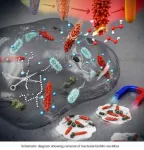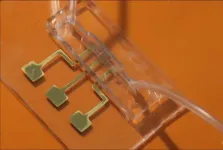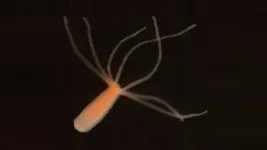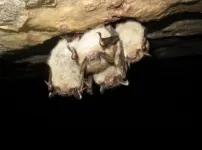Tasmanian tiger pups found to be extraordinary similar to wolf pups
Tasmanian tigers start to look like dogs in the pouch
2021-01-08
(Press-News.org) Micro-CT scanning and digital reconstructions have been used to compare the skulls of the Tasmanian tiger (thylacine) and wolf across their early development and into adulthood, establishing that not only did the thylacine resemble the wolf as adults, but also as newborns and juveniles.
"Remarkably, the Tasmanian tiger pups were more similar to wolf pups than to other closely related marsupials," Professor Andrew Pask from the University of Melbourne said.
The collaborative study with Flinders University and Museums Victoria complement earlier findings that thylacine and wolf have evolved similar instructions in their genome, which influence cranial stem cells during development.
While scientists have worked out that different animals evolve to look the same because they occupy similar places in the ecosystem, they have yet to explain how animals evolve to become convergent, particularly the forces driving their early development. The study provides significant new insights into how animals develop to look a certain way and then when in development these things happen.
Through collaborations with Australian museums and the Museum of the North in Alaska, USA, the team loaned thylacine and wolf skulls of different ages, stages and sizes, from newborns through to fully grown adults. They then applied micro-CT scanning to the skulls to generate digital models which could be compared to determine when during development similarities arose between the thylacine and wolf.
After reconstructing the early pouch development of the thylacine, lead author Dr Axel Newton focused on the question of when during development the Tasmanian tiger establish its dog-like skull shape.
"We know that the thylacine and wolf look similar as adults, but we don't know when they started to exhibit their remarkable similarities during development," he said.
Micro-CT scanning is a technique similar to a medical CAT scan, allowing researchers to generate high-resolution, digital reconstructions of complex shapes such as skulls and bones. From here they were able to establish that not only did the Tasmanian tiger resemble the wolf as adults but were very similar as newborns and juveniles.
Dr Vera Weisbecker, from Flinders University, said all marsupials - including the thylacine - are born with unusually well-developed jaws relative to the rest of the head.
"Scientists think that this reduces the potential of marsupials to evolve some extreme skull shapes. However, it clearly did not prevent the evolution of the thylacine's unusual wolf-like skull!"
The University of Melbourne's Dr Christy Hipsley, who specialises in CT, said the research shows how 3D imaging can reveal hidden diversity in nature.
"By comparing entire growth series from newborns to adults, we were able to visualise tiny differences in development that pinpoint when and where in the skull adaptations to carnivory arise on a cellular level. That is only made possible through museum loans of preserved specimens, in this case from as far away as Alaska."
INFORMATION:
[Attachments] See images for this press release:
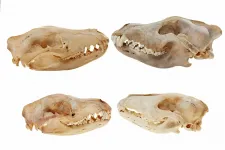
ELSE PRESS RELEASES FROM THIS DATE:
2021-01-08
The COVID-19 pandemic is raising fears of new pathogens such as new viruses or drug-resistant bacteria. To this, a Korean research team has recently drawn attention for developing the technology for removing antibiotic-resistant bacteria by controlling the surface texture of nanomaterials.
A joint research team from POSTECH and UNIST has introduced mixed-FeCo-oxide-based surface-textured nanostructures (MTex) as highly efficient magneto-catalytic platform in the international journal Nano Letters. The team consisted of professors In Su Lee and ...
2021-01-08
COLUMBUS, Ohio - Scientists have figured out a cheaper, more efficient way to conduct a chemical reaction at the heart of many biological processes, which may lead to better ways to create biofuels from plants.
Scientists around the world have been trying for years to create biofuels and other bioproducts more cheaply; this study, published today in the journal Scientific Reports, suggests that it is possible to do so.
"The process of converting sugar to alcohol has to be very efficient if you want to have the end product be competitive with fossil fuels," said Venkat Gopalan, a senior author on the paper and professor of chemistry and biochemistry at The Ohio State University. ...
2021-01-08
The mitochondrial ATP synthase is energy-converting macromolecular machine that uses the electrochemical potential across the bioenergetic membrane called cristae. This potential is maintained via a membrane curvature that is induced by ATP synthase assembled in dimers. The dimers shaping the bioenergetic membrane were thought to be universal across the eukaryotic organisms. Two newly published cryo-EM studies by Kock-Flygaard et al and Mühleip et al from Alexey Amunts lab, identify different types of ATP synthase organization.
The structure of the ATP synthase from ciliates revealed a dimer, which unlike in all the previously investigated complexes, the two ...
2021-01-08
New Curtin University research has found a dramatic increase in people's trust in government in Australia and New Zealand as a result of the COVID pandemic.
Published in the Australian Journal of Public Administration, the team surveyed people in Australia and New Zealand in July 2020 and found confidence in public health scientists to also be high and for this trust to be manifested in higher usage of government COVID phone apps.
Lead researcher Professor Shaun Goldfinch, ANZSOG WA Government Chair in Public Administration and Policy based at the John Curtin Institute of Public Policy at Curtin said the management of the pandemic by authorities led to a dramatic increase in trust in government.
"Using an online panel, we surveyed a representative sample of 500 people each in Australia ...
2021-01-08
An important and still unanswered question is how new genes that cause antibiotic resistance arise. In a new study, Swedish and American researchers have shown how new genes that produce resistance can arise from completely random DNA sequences. The results have been published in the journal PLOS Genetics.
Antibiotic resistance is a major global problem and the spread of resistant bacteria causes disease and death, and constitutes a major cost to society. The most common way for bacteria to develop resistance is by taking up various types of resistance genes from other bacteria. These genes encode proteins (peptides) that can lead to resistance by: (i) deactivating the antibiotic, (ii) reducing its concentration, or (iii) altering ...
2021-01-08
PITTSBURGH--Researchers at Carnegie Mellon University report findings on an advanced nanomaterial-based biosensing platform that detects, within seconds, antibodies specific to SARS-CoV-2, the virus responsible for the COVID-19 pandemic. In addition to testing, the platform will help to quantify patient immunological response to the new vaccines with precision.
The results were published this week in the journal Advanced Materials. Carnegie Mellon's collaborators included the University of Pittsburgh (Pitt) and the UPMC.
The testing platform identifies the presence of two of the virus' antibodies, spike S1 protein and receptor binding domain (RBD), in a ...
2021-01-08
Leg amputees are often not satisfied with their prosthesis, even though the sophisticated prostheses are becoming available. One important reason for this is that they perceive the weight of the prosthesis as too high, despite the fact that prosthetic legs are usually less than half the weight of a natural limb. Researchers led by Stanisa Raspopovic, a professor at the Department of Health Sciences and Technology, have now been able to show that connecting the prostheses to the nervous system helps amputees to perceive the prosthesis weight as lower, which ...
2021-01-08
Stay awake too long, and thinking straight can become extremely difficult. Thankfully, a few winks of sleep is often enough to get our brains functioning up to speed again. But just when and why did animals start to require sleep? And is having a brain even a prerequisite?
In a study that could help to understand the evolutional origin of sleep in animals, an international team of researchers has shown that tiny, water-dwelling hydras not only show signs of a sleep-like state despite lacking central nervous systems but also respond to molecules associated ...
2021-01-08
Since 2006, a fungal disease called white-nose syndrome has caused sharp declines in bat populations across the eastern United States. The fungus that causes the disease, Pseudogymnoascus destructans, thrives in subterranean habitats where bats hibernate over the winter months.
Bats roosting in the warmest sites have been hit particularly hard, since more fungus grows on their skin, and they are more likely to die from white-nose syndrome, according to a new study by researchers at Virginia Tech.
But instead of avoiding these warm and deadly sites, bats continue to use them year after year. The reason? Bats are mistakenly preferring sites where fungal growth is ...
2021-01-08
An invisible flow of groundwater seeps into the ocean along coastlines all over the world. Scientists have tended to disregard its contributions to ocean chemistry, focusing on the far greater volumes of water and dissolved material entering the sea from rivers and streams, but a new study finds groundwater discharge plays a more significant role than had been thought.
The new findings, published January 8 in Nature Communications, have implications for global models of biogeochemical cycles and for the interpretation of isotope records of Earth's climate history.
"It's really hard to characterize groundwater discharge, so it has been a source of uncertainty in the modeling of global cycles," said first author Kimberley Mayfield, who led the study as ...
LAST 30 PRESS RELEASES:
[Press-News.org] Tasmanian tiger pups found to be extraordinary similar to wolf pups
Tasmanian tigers start to look like dogs in the pouch

